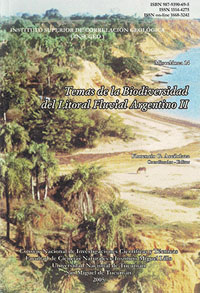Miscelánea 14
Biodiversidad en ríos del litoral fluvial. Utilidad del software PULSO.
Silvina L. Casco | Matías Neiff | Juan José Neiff
Descargar trabajo en formato PDFAbstract
The efforts of the Ecologists have been directed to know the number of species that inhabiting in a river and their basin. However, an smaller number of projects had been dedicated to study the causes of the biodiversity in systems with a high level of fluctuation. In this contribution available information of the Paraná River floodplain is discussed and a methodological advance for to link the biological and hydrological complexity it presents because, that is useful to interpret the biodiversity of the assemble of plants and animals that grow under different flood and dry conditions of the floodplain wetlands. PULSO is a tool to study the fluctuations and deposition of nutrients in floodplains, the causes and distribution and abundance of organisms in rivers and wetlands, to analyze the effects of catastrophic floods, and to understand the present structure of landscapes in fluctuating systems. PULSO is not a procedure for hydrological analysis, but a tool to diagnose the cause the structure or process related to fluctuating hydrological behavior typical of flood plains, wetlands flooded periodically by rain, and coastal areas under tidal regimes. The function and structure of rivers with floodplains are conditioned by pulses of energy and materials or hydrosedimentological pulses. The dynamics of pulses are characterized by hydrological attributes defined by the function f FITRAS, which is the acronym for Frequency, Intensity, Tension or stress, Regularity, Amplitude, and Seasonality. The pulsing regime is comprised of the pattern of variability of these phases within a certain time and space, conforming to a sinusoidal model that results, as we have said, from introducing in the hydrometric curve a reference level or an upper bankfull level where the river spills into the flood plain. PULSO works well with hydrometric data or the depth of a river or wetland, it is also able to be used to analyze situations or analogous processes. The user introduces a temporal series of data (hydrogram), selects the length of period of time to analyze and a value of intensity (reference value) which defines the incident of a process (flooding for example) or the presence of a determined element of the system (a forest of a certain species for example). With hydrometric data (of rivers) or depth (in wetlands), daily, weekly or annually taken above (or previously) in a city near the floodplain studied, it is possible to know the number of pulses, the number of flood and dry phases, the season of the year in which they occur, their duration, the magnitude that they reached and the regularity of the regime. The analysis of the fluvial pulses takes places for each sector of the flood plain as such their topographic position determines the distinct time of the potamophase/limnophase. Calculation of the function f FITRAS for the sites in which each species of tree grows, or in which each landscape is located, allows knowing quantitatively the influence of the hydrological phenomena in these sites. The reader is guided step to step in the use of the software using some examples for forests located in different topographical elevation within the floodplain river.






